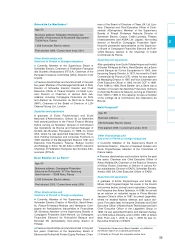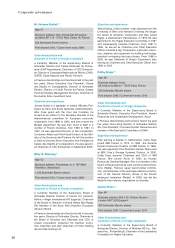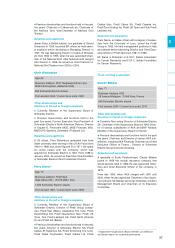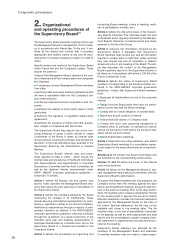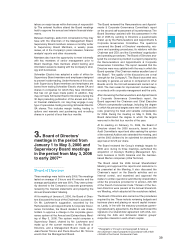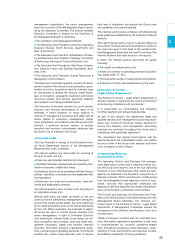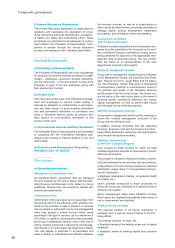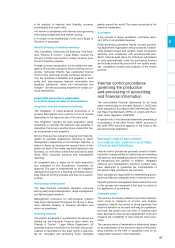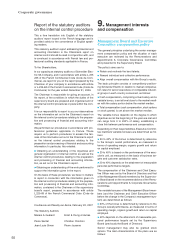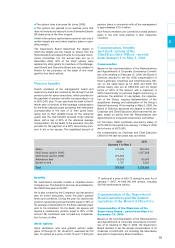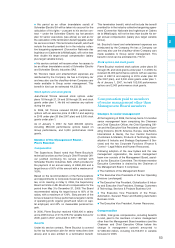APC 2006 Annual Report Download - page 46
Download and view the complete annual report
Please find page 46 of the 2006 APC annual report below. You can navigate through the pages in the report by either clicking on the pages listed below, or by using the keyword search tool below to find specific information within the annual report.
Disqualified by a court from acting as a member of
the administrative, management or supervisory bodies
of an issuer or from acting in the management or con-
duct of the affairs of an issuer.
Involved, as a member of an administrative, man-
agement or supervisory body or a partner, in a bank-
ruptcy, receivership or liquidation.
None of the members of the Supervisory Board or
Management Board are related to each other.
There are no arrangements or understandings with
major shareholders, customers, suppliers or others
pursuant to which a member of the Supervisory Board
or Management Board has been selected as a mem-
ber of an administrative, management or supervisory
body or a member of senior management.
There are no conflicts of interests between any duties
to Schneider Electric SA of the members of the Super-
visory Board or Management Board and their private
interests.
8. Internal Control**
To anticipate and control the risks associated with its
operations, as well as the risk of accounting and other
errors and fraud, procedures have been established at
Group level that ensure effective risk management.
The purpose of these procedures is to:
Ensure that management actions, transactions and
employee behavior are consistent with the overall busi-
ness strategy decided by the Supervisory Board and
Management Board of Schneider Electric SA, the
Group’s parent company, that they comply with the
applicable laws and regulations and that they reflect
the Group's values and internal standards and rules.
Obtain assurance that statutory and management
accounting data presented to the Supervisory Board
and Management Board of Schneider Electric SA and
Group senior management present fairly the sales,
results of operations and financial position of the
Group.
No system of internal control designed to fulfill the
above objectives is capable of providing absolute
assurance that the objectives will be met due to the
inherent limitations of procedures, however well con-
ceived. The internal control process is a work in
progress; procedures are adapted to reflect changes in
the business and regulatory environment, as well as in
the Group’s organization. The different participants in
the process ensure that procedures are regularly
updated and circulated throughout the Group.
This report was prepared on the basis of discussions
among these participants, in particular senior manage-
ment, Finance & Control - Legal Affairs, and the inter-
nal auditors. It is supported by a review of the internal
control resources and procedures deployed by the
Group.
Internal Control Organization
Control environment:
key participants and responsibilities
a) Supervisory Board, Audit Committee
and Remunerations and Appointments
& Corporate Governance Committee
In accordance with article L.225-68 of the French
Commercial Code, the Supervisory Board exercises
permanent oversight over the Company’s manage-
ment by the Management Board, which has the broad-
est powers in relation to third parties to act in all cir-
cumstances in the Company’s name.
In addition to performing ex-post controls as part of its
oversight activities, the Supervisory Board also per-
forms ex-ante controls, particularly in the areas of
financing and the implementation of Group strategy.
The Company’s bylaws and the Supervisory Board’s
internal rules state that the Management Board must
obtain the Supervisory Board’s prior authorization
before carrying out any debt or equity financing trans-
actions that would significantly alter the Company’s
balance sheet structure, or before deciding any mate-
rial business acquisitions or disposals.
The Supervisory Board’s ex-post controls include
reviewing the financial statements approved by the
Management Board. As part of its review, the Supervi-
sory Board obtains assurance as to whether the
accounting policies used are appropriate and have
been applied consistently from one period to the next,
whether transactions that are material at Group level
have been properly accounted for and whether the
rules governing the inclusion of companies in the
scope of consolidation have been properly applied.
The Supervisory Board also obtains assurance con-
cerning the reliability of the system of internal control.
The Audit Committee reports to the Supervisory Board
on its review of the internal audit organization, pro-
grams and findings, as well as on any examination of
financial or accounting risk management issues per-
formed at the Committee’s own initiative or at the
request of the Supervisory Board, the Supervisory
Board Chairman or the Management Board Chairman.
The Supervisory Board ensures that the Management
Board functions efficiently and effectively. It sets the
compensation of Management Board members, based
on a report drawn up by the Remunerations and
Appointments & Corporate Governance Committee.
Through the Remunerations and Appointments & Cor-
porate Governance Committee, it obtains information
about the senior management compensation policy
decided by the Management Board and authorizes the
creation of stock option and stock grant plans.
b) Senior Management
Until May 3, 2006, Group senior management was
organized around the Direction and Strategy Commit-
tee, chaired by Henri Lachmann, Chairman and Chief
Executive Officer, and the Operations Committee,
chaired by Jean-Pascal Tricoire, Chief Operating Officer.
Following adoption of the new bylaws and the new
Corporate governance
44
**Paragraphs 2 through 4 and paragraph 8 make up
the Chairman’s report prepared in accordance with article
L225-68 of the French Commercial Code.



